Differential Effects of Sulfur Fertilization on Soil Microbial Communities and Maize Yield Enhancement
Abstract
:1. Introduction
2. Materials and Methods
2.1. Field Sites and Sample Collection
2.2. Soil Properties and Maize Yield Determination
2.3. Illumina MiSeq High-Throughput Sequencing and Data Analysis
2.4. Statistical Analysis
3. Results
3.1. Effects of Different S Types Application on Maize Yield
3.2. Effects of Different S Types Application on Soil Properties
3.3. Effects of Different S Types Application on Bacterial Alpha Diversity and Community Structure
3.4. Effects of Different S Types Application on Bacterial Community Stability
3.5. Driving Factors of Rare and Abundant Taxa
3.6. Effect of Different Types S Fertilization-Driven Soil Properties on Maize Yields
3.7. Predictive Functional Analysis of Abundant and Rare Taxa under Different S Applications
4. Discussion
4.1. The Effect of Different S Fertilizer Applications on Maize Yield
4.2. The Effect of Different S Fertilizer Applications on Soil Properties
4.3. The Effect of Different S Application on Rare and Abundant Bacterial Communities
4.4. The Mechanism of Rare and Abundant Taxa Regulating Maize Yield
4.5. The Effects of Different S Applications on the Functions of Rare and Abundant Taxa
5. Conclusions
Supplementary Materials
Author Contributions
Funding
Data Availability Statement
Conflicts of Interest
References
- Chaudhary, S.; Sindhu, S.S.; Dhanker, R.; Kumari, A. Microbes-mediated sulphur cycling in soil: Impact on soil fertility, crop production and environmental sustainability. Microbiol. Res. 2023, 271, 127340. [Google Scholar] [CrossRef] [PubMed]
- Maruyama Nakashita, A. Metabolic changes sustain the plant life in low-sulfur environments. Curr. Opin. Plant Biol. 2017, 39, 144–151. [Google Scholar] [CrossRef] [PubMed]
- Sutar, R.K.; Pujar, A.M.; Kumar, B.N.A.; Hebsur, N.S. Sulphur nutrition in maize a critical review. Int. J. Pure Appl. Biosci. 2018, 5, 1582–1596. [Google Scholar] [CrossRef]
- Kulczycki, G. The effect of elemental sulfur fertilization on plant yields and soil properties. Adv. Agron. 2021, 167, 105–181. [Google Scholar] [CrossRef]
- Carciochi, W.D.; Wyngaard, N.; Divito, G.A.; Calvo, N.I.R.; Cabrera, M.L.; Echeverría, H.E. Diagnosis of sulfur availability for corn based on soil analysis. Biol. Fertil. Soils 2016, 52, 917–926. [Google Scholar] [CrossRef]
- Sutradhar, A.K.; Kaiser, D.E.; Fernández, F.G. Does total nitrogen/sulfur ratio predict nitrogen or sulfur requirement for corn? Soil Sci. Soc. Am. J. 2017, 81, 564–577. [Google Scholar] [CrossRef]
- Malik, A.A.; Puissant, J.; Buckeridge, K.M.; Goodall, T.; Jehmlich, N.; Chowdhury, S.; Gweon, H.S.; Peyton, J.M.; Mason, K.E.; van Agtmaal, M.; et al. Land use driven change in soil pH affects microbial carbon cycling processes. Nat. Commun. 2018, 9, 3591. [Google Scholar] [CrossRef]
- Zenda, T.; Liu, S.; Dong, A.; Duan, H. Revisiting Sulphur—The Once Neglected Nutrient: It’s Roles in Plant Growth, Metabolism, Stress Tolerance and Crop Production. Agriculture 2021, 11, 626. [Google Scholar] [CrossRef]
- Fageria, N.K.; dos Santos, A.B.; Moraes, M.F. Influence of Urea and Ammonium Sulfate on Soil Acidity Indices in Lowland Rice Production. Commun. Soil Sci. Plant Anal. 2010, 41, 1565–1575. [Google Scholar] [CrossRef]
- Anwari, G.; Tianxu, Y.; Alio Moussa, A.; Wentao, Z.; Mandozai, A.; Gamal, M.; Feng, J. Influence of biochar and aluminum sulfate on rice growth and production in saline soil. J. Crop Improv. 2022, 37, 776–795. [Google Scholar] [CrossRef]
- Eriksen, J. Gross sulphur mineralization-immobilization turnover in soil amended with plant residues. Soil Biol. Biochem. 2005, 37, 2216–2224. [Google Scholar] [CrossRef]
- Bolan, N.S.; Hedley, M.J. Role of carbon, nitrogen, and sulfur cycles in soil acidification. Acidification of soils. In Handbook of Soil Acidity, 1st ed.; CRC Press: Boca Raton, FL, USA, 2003; pp. 29–56. [Google Scholar]
- Scherer, H.W. Sulfur in soils. J. Plant Nutr. Soil Sci. 2009, 172, 326–335. [Google Scholar] [CrossRef]
- Wang, M.; Wang, L.; Shi, H.; Liu, Y.; Chen, S. Soil bacteria, genes, and metabolites stimulated during sulfur cycling and cadmium mobilization under sodium sulfate stress. Environ. Res. 2021, 201, 111599. [Google Scholar] [CrossRef] [PubMed]
- Pedrós-Alió, C. The rare bacterial biosphere. Annu. Rev. Mar. Sci. 2012, 4, 449–466. [Google Scholar] [CrossRef] [PubMed]
- Parvathi, A.; Catena, M.; Jasna, V.; Phadke, N.; Gogate, N. Influence of hydrological factors on bacterial community structure in a tropical monsoonal estuary in India. Environ. Sci. Pollut. Res. 2021, 28, 50579–50592. [Google Scholar] [CrossRef] [PubMed]
- Lauber, C.; Ramirez, K.; Aanderud, Z.; Jay, L.; Noah, F. Temporal variability in soil microbial communities across land-use types. ISME J. 2013, 7, 1641–1650. [Google Scholar] [CrossRef]
- Jousset, A.; Bienhold, C.; Chatzinotas, A.; Gallien, L.; Gobet, A.; Kurm, V.; Hol, W.H. Where less may be more: How the rare biosphere pulls ecosystems strings. ISME J. 2017, 11, 853–862. [Google Scholar] [CrossRef] [PubMed]
- Lynch, M.; Neufeld, J. Ecology and exploration of the rare biosphere. Nat. Rev. Microbiol. 2015, 13, 217–229. [Google Scholar] [CrossRef]
- Pester, M.; Bittner, N.; Deevong, P.; Wagner, M.; Loy, A. A ‘rare biosphere’ microorganism contributes to sulfate reduction in a peatland. ISME J. 2010, 4, 1591–1602. [Google Scholar] [CrossRef]
- Sauret, C.; Séverin, T.; Vétion, G.; Guigue, C.; Goutx, M.; Pujo-Pay, M.; Conan, P.; Fagervold, S.K.; Ghiglione, J.F. Rare biosphere’ bacteria as key phenanthrene degraders in coastal seawaters. Environ. Pollut. 2014, 194, 246–253. [Google Scholar] [CrossRef]
- Pennekamp, F.; Pontarp, M.; Tabi, A.; Altermatt, F.; Alther, R.; Choffat, Y.; Fronhofer, E.A.; Ganesanandamoorthy, P.; Garnier, A.; Griffiths, J.I.; et al. Biodiversity increases and decreases ecosystem stability. Nature 2018, 563, 109–112. [Google Scholar] [CrossRef] [PubMed]
- Bao, P.; Li, G.X.; Sun, G.X.; Xu, Y.Y.; Meharg, A.A.; Zhu, Y.G. The role of sulfate-reducing prokaryotes in the coupling of element biogeochemical cycling. Sci. Total Environ. 2018, 613, 398–408. [Google Scholar] [CrossRef] [PubMed]
- Yu, H.; Ling, N.; Wang, T.; Zhu, C.; Wang, Y.; Wang, S.; Gao, Q. Responses of soil biological traits and bacterial communities to nitrogen fertilization mediate maize yields across three soil types. Soil Tillage Res. 2019, 185, 61–69. [Google Scholar] [CrossRef]
- Gill, S.R.; Pop, M.; DeBoy, R.T.; Eckburg, P.B.; Turnbaugh, P.J.; Samuel, B.S.; Gordon, J.I.; Relman, D.A.; Fraser-Liggett, C.M.; Nelson, K.E. Metagenomic analysis of the human distal gut microbiome. Science 2006, 312, 1355–1359. [Google Scholar] [CrossRef] [PubMed]
- Chen, H.; Jiang, W. Application of high-throughput sequencing in understanding human oral microbiome related with health and disease. Front. Microbiol. 2014, 5, 6. [Google Scholar] [CrossRef] [PubMed]
- Caporaso, J.G.; Kuczynski, J.; Stombaugh, J.; Bittinger, K.; Bushman, F.D.; Costellz, E.K.; Fierer, N.; Pena, A.G.; Goodrich, J.K.; Gordon, J.I.; et al. QIIME allows analysis of high-throughput community sequencing data. Nat. Methods 2010, 7, 335–336. [Google Scholar] [CrossRef]
- Bolyen, E.; Rideout, J.R.; Dillon, M.R.; Bokulich, N.A.; Abnet, C.C.; Al-Ghalith, G.A.; Alexander, H.; Alm, E.J.; Arumugam, M.; Asnicar, F.; et al. Reproducible, interactive, scalable and extensible microbiome data science using QIIME 2. Nat. Biotechnol. 2019, 37, 852–857. [Google Scholar] [CrossRef]
- Dong, S.; Zhang, B.; Wang, Z.; Zhou, X.; Gao, Q. Responses of soil bacterial communities and maize yields to sulfur application across four soil types. Front. Microbiol. 2024, 13, 1329938. [Google Scholar] [CrossRef]
- He, Z.; Liu, D.; Shi, Y.; Wu, X.; Dai, Y.; Shang, Y.; Peng, J.; Cui, Z. Broader environmental adaptation of rare rather than abundant bacteria in reforestation succession soil. Sci. Total Environ. 2022, 828, 154364. [Google Scholar] [CrossRef]
- Pan, C.; Feng, Q.; Li, Y.; Li, Y.; Liu, L.; Yu, X.; Ren, S. Rare soil bacteria are more responsive in desertification restoration than abundant bacteria. Environ. Sci. Pollut. Res. 2022, 29, 33323–33334. [Google Scholar] [CrossRef]
- Zhou, Z.; Zhang, Y.; Zhang, F. Abundant and rare bacteria possess different diversity and function in crop monoculture and rotation systems across regional farmland. Soil Biol. Biochem. 2022, 171, 108742. [Google Scholar] [CrossRef]
- Skwierawska, M.; Zawartka, L.; Zawadski, B. The effect of different rates and forms of sulphur applied on changes of soil agrochemical properties. Plant Soil Environ. 2008, 54, 171–177. [Google Scholar] [CrossRef]
- Du, X.; Liu, G.; Pu, P.; Liu, J.; Li, W.; Xu, X. Effects of SO42−-S and S0-S on the Sultur Nutrition in Pakchoi. J. Nucl. Agric. Sci. 2020, 34, 0635–0641. [Google Scholar] [CrossRef]
- Jiang, M.; Dong, C.; Bian, W.; Zhang, W.; Wang, Y. Effects ofdifferent fertilization practices on maize yield, soil nutrients, soil moisture, and water use efficiency in northern China based on a meta-analysis. Sci. Rep. 2024, 14, 6480. [Google Scholar] [CrossRef]
- Khan, K.S.; Joergensen, R.G. Microbial C, N, and P relationships in moisture–stressed soils of a semiarid subtropical forest after nitrogen and sulfur amendments. Soil Biol. Biochem. 2006, 38, 2902–2911. [Google Scholar] [CrossRef]
- Masuda, S.; Bao, Z.; Okubo, T.; Sasaki, K.; Ikeda, S.; Shinoda, R.; Anda, M.; Kondo, R.; Mori, Y.; Minamisawa, K. Sulfur Fertilization Changes the Community Structure of Rice Root-, and Soil- Associated Bacteria. Microbes Environ. 2016, 31, 70–75. [Google Scholar] [CrossRef]
- McGrath, S.P.; Zhao, F.J.; Blake-Kalff, M.M.A. History and outlook for sulfur fertilizers in Europe. Commun. Soil Sci. Plant Anal. 2002, 33, 421–425. [Google Scholar]
- Eriksen, J.; Mortensen, J.V. Effects of timing of sulphur application on yield, S-uptake and quality of barley. Agron. J. 2002, 94, 493–499. [Google Scholar] [CrossRef]
- Zhao, F.J.; McGrath, S.P. Biofortification and phytoremediation. Curr. Opin. Plant Biol. 2009, 12, 373–380. [Google Scholar] [CrossRef]
- Klose, S.; Bilen, S.; Ali Tabatabai, M.; Dick, W.A. Sulfur Cycle Enzymes. Soil Biol. Biochem. 2011, 9, 125–159. [Google Scholar] [CrossRef]
- Kunito, T.; Kurita, H.; Kumori, M.; Sakaguchi, K.; Nishizawa, S.; Fujita, K.; Moro, H.; Sawada, K.; Miyabara, Y.; Toda, H.; et al. Microbial synthesis of arylsulfatase depends on the soluble and adsorbed sulfate concentration in soils. Eur. J. Soil Biol. 2022, 111, 103418. [Google Scholar] [CrossRef]
- Chen, H.; Yang, L.; Wen, L.; Luo, P.; Liu, L.; Yang, Y.; Wang, K.; Li, D. Effects of nitrogen deposition on soil sulfur cycling, Global Biogeochem. Cycles 2016, 30, 1568–1577. [Google Scholar] [CrossRef]
- Chen, H.; Liu, J.; Li, D.; Xiao, K.; Wang, K. Controls on soil arylsulfatase activity at a regional scale. Eur. J. Soil Biol. 2019, 90, 9–14. [Google Scholar] [CrossRef]
- Yang, Y.; Cheng, K.; Li, K.; Jin, Y.; He, X. Deciphering the diversity patterns and community assembly of rare and abundant bacterial communities in a wetland system. Sci. Total Environ. 2022, 838, 156334. [Google Scholar] [CrossRef]
- Li, G.L.; Meng, W.U.; Li, P.F.; Wei, S.P.; Jia, L.I.U.; Jiang, C.Y.; Ming, L.I.U.; Li, Z.P. Assembly and co-occurrence patterns of rare and abundant bacterial sub-communities in rice rhizosphere soil under short-term nitrogen deep placement. J. Integr. Agric. 2021, 20, 3299–3311. [Google Scholar] [CrossRef]
- Ma, Y.; Oliveira, R.S.; Nai, F.; Rajkumar, M.; Luo, Y.; Rocha, I.; Freitas, H. The hyperaccumulator Sedum plumbizincicola harbors metal-resistant endophytic bacteria that improve its phytoextraction capacity in multi-metal contaminated soil. J. Environ. Manag. 2015, 156, 62–69. [Google Scholar] [CrossRef] [PubMed]
- Ferreira, E.D.B.; Stone, L.F.; Martin-Didonet, C.C.G. Populacao e atividade microbiana do solo em sistema agroecologico de producao. Rev. Cienc. Agron. 2017, 48, 3–22. [Google Scholar] [CrossRef]
- Schmalenberger, A.; Telford, A.; Kertesz, M. Sulfate treatment affects desulfonating bacterial community structures in Agrostis rhizospheres as revealed by functional geneanalysis based on asfA. Eur. J. Soil Biol. 2010, 46, 248–254. [Google Scholar] [CrossRef]
- Lu, Y.; Cong, P.; Kuang, S.; Tang, L.; Li, Y.; Dong, J.; Song, W. Long-term excessive application of K2SO4 fertilizer alters bacterial community and functional pathway of tobacco-planting soil. Front. Plant Sci. 2022, 13, 1005303. [Google Scholar] [CrossRef] [PubMed]
- Deltedesco, E.; Keiblinger, K.M.; Piepho, H.P.; Antonielli, L.; Pötsch, E.M.; Zechmeister-Boltenstern, S.; Gorfer, M. Soil microbial community structure and function mainly respond to indirect effects in a multifactorial climate manipulation experiment. Soil Biol. Biochem. 2020, 142, 107704. [Google Scholar] [CrossRef]
- Zhalnina, K.; Dias, R.; de Quadros, P.D.; Davis-Richardson, A.; Camargo, F.A.; Clark, I.M.; McGrath, S.P.; Hirsch, P.R.; Triplett, E.W. Soil pH determines microbial diversity and composition in the Park Grass Experiment. Nat. Microbiol. 2015, 69, 395–406. [Google Scholar] [CrossRef] [PubMed]
- Zhou, J.; Lao, Y.-M.; Song, J.-T.; Jin, H.; Zhu, J.-M.; Cai, Z.-H. Temporal heterogeneity of microbial communities and metabolic activities during a natural algal bloom. Water Res. 2020, 183, 116020. [Google Scholar] [CrossRef] [PubMed]
- Gupta, V.; Lawrence, J.; Germida, J. Impact of elemental sulfur fertilization on agricultural soils. i. effects on microbial biomass and enzyme activities. Can. J. Soil Sci. 1988, 68, 463–473. [Google Scholar] [CrossRef]
- Tripathi, B.M.; Kim, M.; Lai-Hoe, A.; Shukor, N.A.; Rahim, R.A.; Go, R.; Adams, J.M. pH dominates variation in tropical soil archaeal diversity and community structure. FEMS Microbiol. Ecol. 2013, 86, 303–311. [Google Scholar] [CrossRef] [PubMed]
- Tripathi, B.M.; Kim, M.; Tateno, R.; Kim, W.; Wang, J.J.; Lai-Hoe, A.; Ab Shukor, N.A.; Rahim, R.A.; Go, R.; Adams, J.M. Soil pH and biome are both key determinants of soil archaeal community structure. Soil Biol. Biochem. 2015, 88, 1–8. [Google Scholar] [CrossRef]
- Duan, L.; Yu, Q.; Zhang, Q.; Wang, Z.; Pan, Y.; Larssen, T.; Tang, J.; Mulder, J. Acid deposition in Asia: Emissions, deposition, and ecosystem effects. Atmos. Environ. 2016, 146, 55–69. [Google Scholar] [CrossRef]
- Liu, H.; Dai, Z.; Wang, Y.; Ma, X.; Shi, Z.; Wang, R.; Xu, Z.; Li, H.; Han, X.; Jiang, Y. Interacting effects of water and nitrogen addition on soil–plant sulfur dynamics in a semi-arid grassland. Geoderma 2024, 442, 116796. [Google Scholar] [CrossRef]
- Jiao, S.; Wang, J.; Wei, G.; Chen, W.; Lu, Y. Dominant role ofabundant rather than rare bacterial taxa in maintaining agro-soil microbiomes under environmental disturbances. Chemosphere 2019, 235, 248–259. [Google Scholar] [CrossRef]
- Wagg, C.; Bender, S.F.; Widmer, F.; van der Heijden, M.G. Soil biodiversity and soil community composition determine ecosystem multifunctionality. Proc. Natl. Acad. Sci. USA 2014, 111, 5266–5270. [Google Scholar] [CrossRef]
- Zhao, R.; Liu, J.; Feng, J.; Li, X.; Li, B. Microbial community composition and metabolic functions in landfill leachate from different landfills of China. Sci. Total Environ. 2021, 767, 144861. [Google Scholar] [CrossRef]
- Hu, C.; Yang, Z.; Chen, Y.; Tang, J.; Zeng, L.; Cong, P.; Chen, L.; Wang, J. Unlocking soil revival: The role of sulfate-reducing bacteria in mitigating heavy metal contamination. Environ. Geochem. Health 2024, 46, 417. [Google Scholar] [CrossRef] [PubMed]
- Li, Y.; Gao, W.; Wang, C.; Gao, M. Distinct distribution patterns and functional potentials of rare and abundant microorganisms between plastisphere and soils. Sci. Total Environ. 2023, 873, 162413. [Google Scholar] [CrossRef] [PubMed]
- Wang, Y.W.; Bai, D.S.; Yang, X.; Zhang, Y.; Luo, X.G. Soil sulfur cycle bacteria and metabolites affected by soil depth and afforestation conditions in high-sulfur coal mining areas. Appl. Soil Ecol. 2023, 185, 104802. [Google Scholar] [CrossRef]
- Wang, X.; Zhou, Z.; Zijing, L.; Xia, L.; Song, S.; Meza, J.V.G.; Montes, M.L.; Li, J. Surge of native rare taxa in tailings soil induced by peat bacterial invasion. Sci. Total Environ. 2024, 908, 168596. [Google Scholar] [CrossRef] [PubMed]
- Marzec-Grządziel, A.; Gałązka, A. Sequencing of the Whole Genome of a Bacterium of the Genus Achromobacter Reveals Its Potential for Xenobiotics Biodegradation. Agriculture 2023, 13, 1519. [Google Scholar] [CrossRef]
- Liu, S.; Cui, S.; Ying, F.; Nasar, J.; Wang, Y.; Gao, Q. Simultaneous improvement of protein concentration and amino acid balance in maize grains by coordination application of nitrogen and sulfur. J. Cereal Sci. 2021, 99, 103189. [Google Scholar] [CrossRef]
- Xin, Y.; Ji, L.; Wang, Z.; Li, K.; Xu, X.; Guo, D. Functional Diversity and CO2 Emission Characteristics of Soil Bacteria during the Succession of Halophyte Vegetation in the Yellow River Delta. Int. J. Environ. Res. Public Health 2022, 19, 12919. [Google Scholar] [CrossRef] [PubMed]
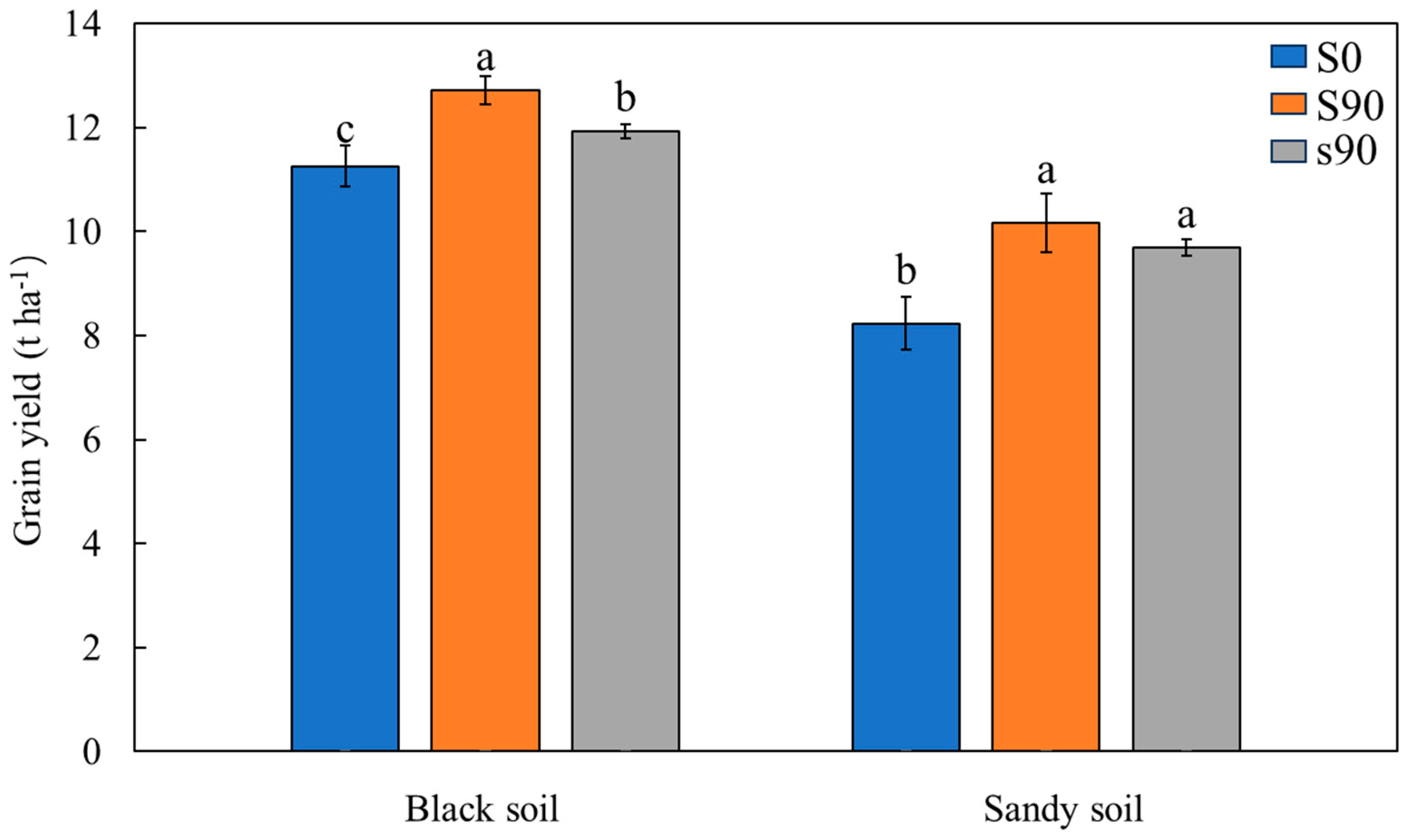

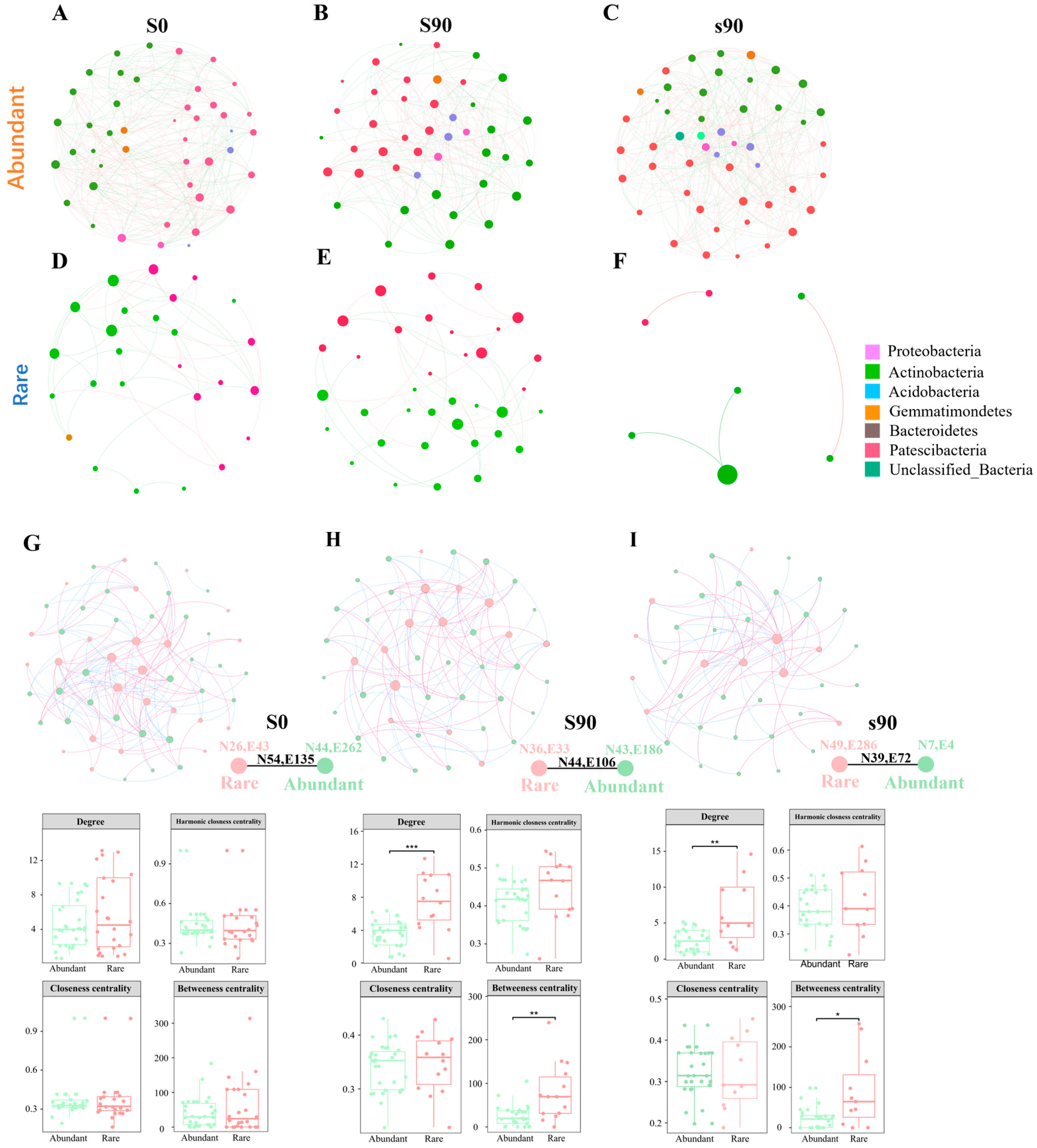
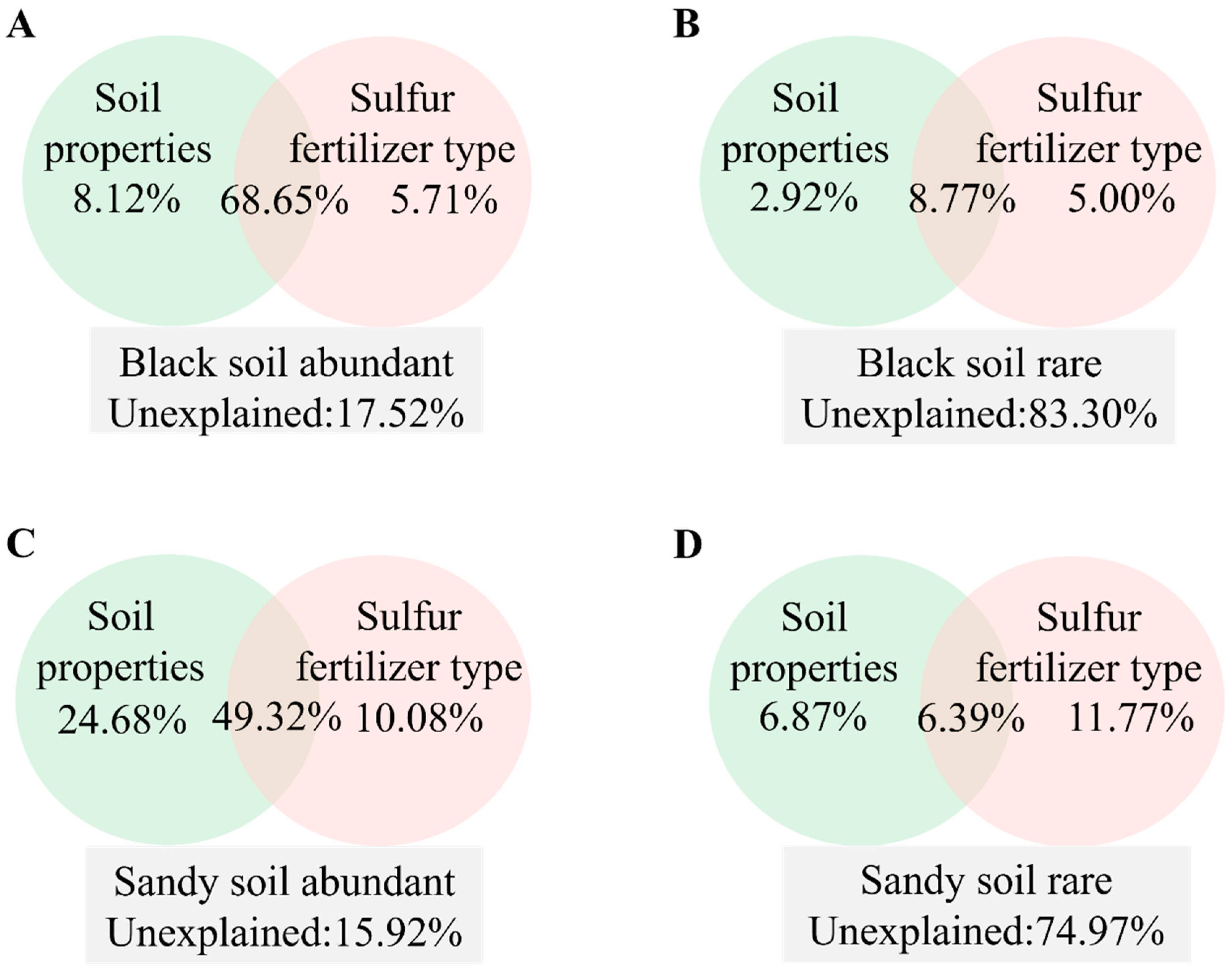
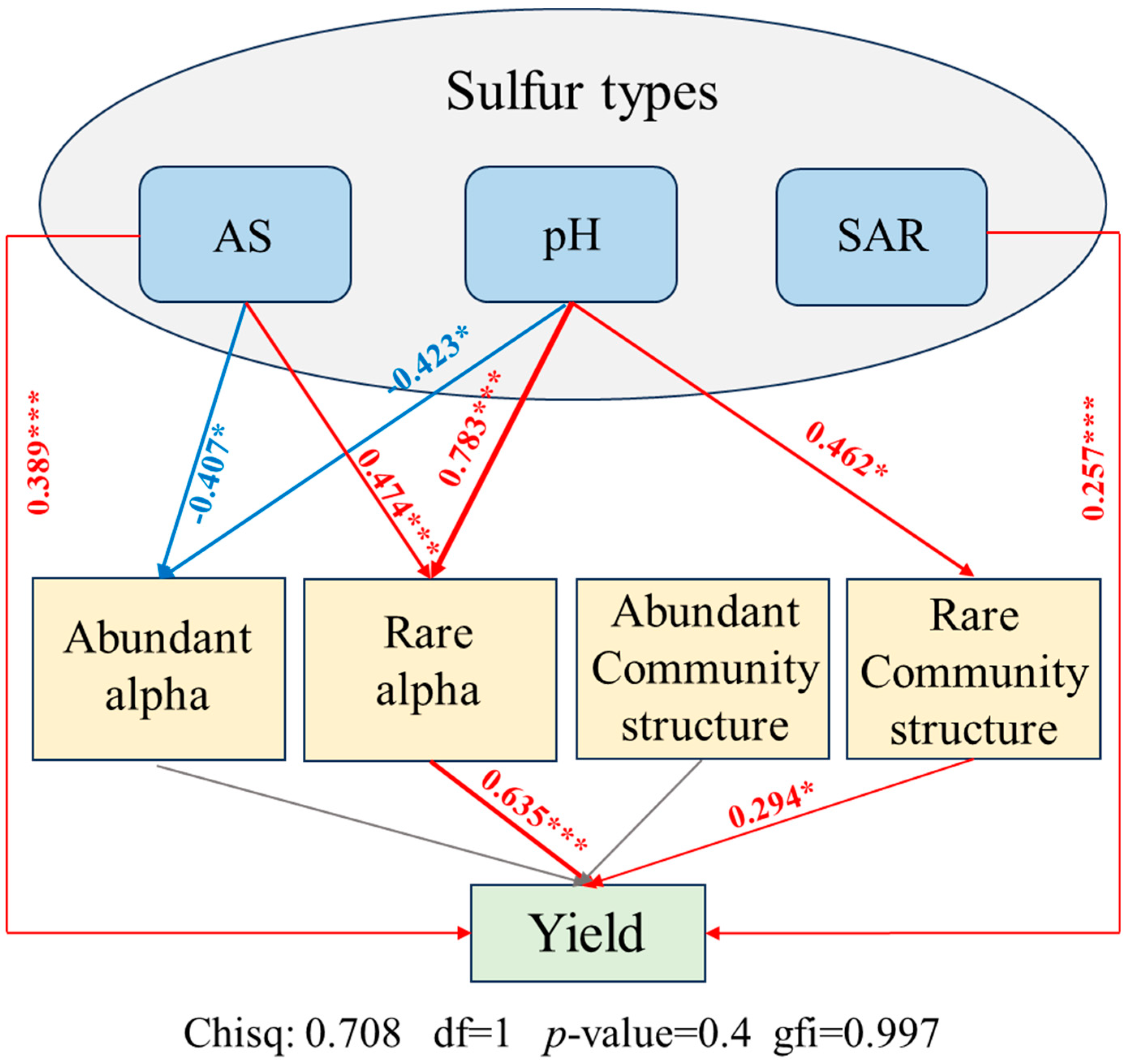
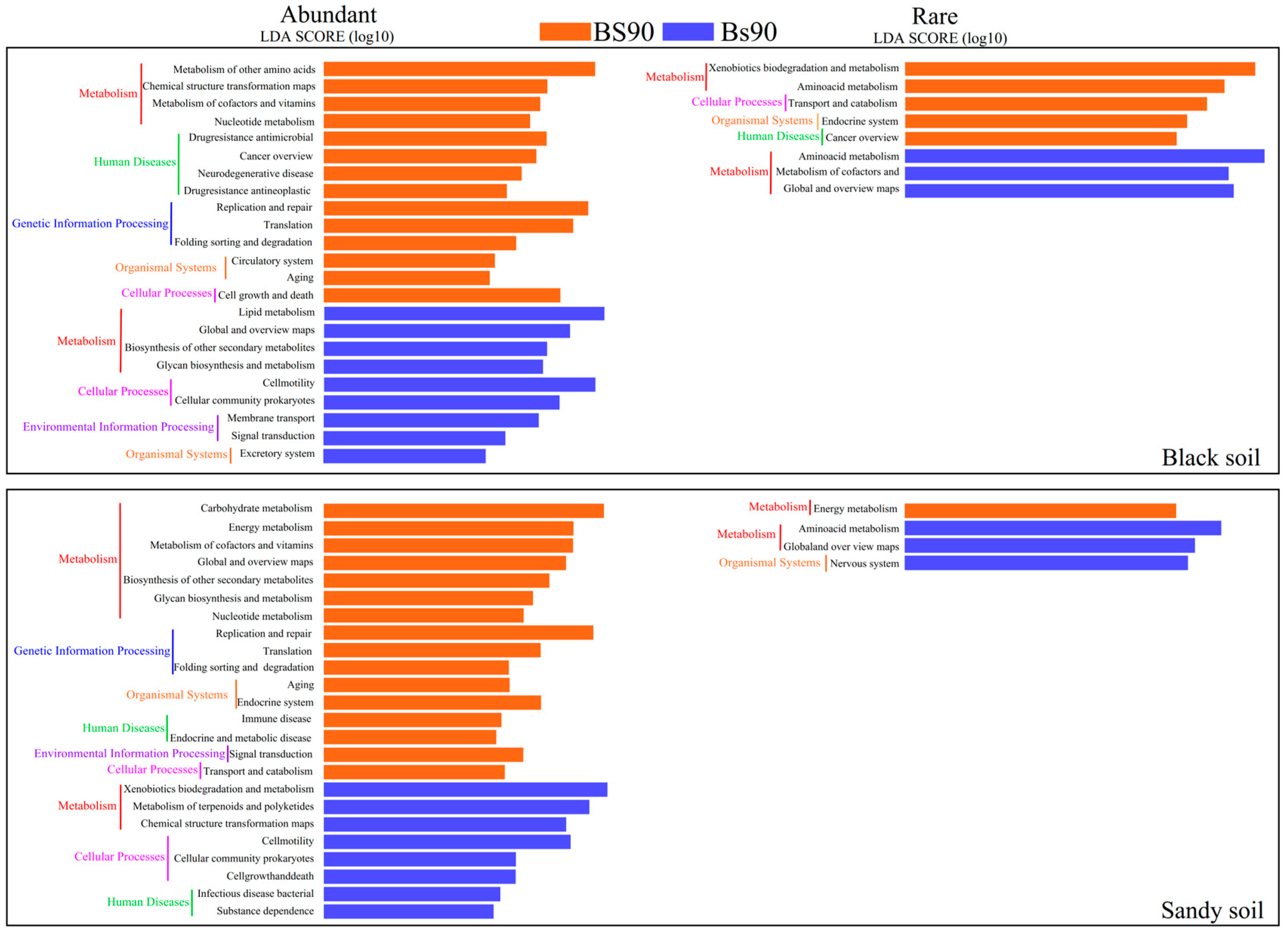
| Soil Types | Sample | pH | OM Organic Matter (g kg−1) | AS Available Sulfur (mg kg−1) | SAR Aryl Sulfatase (nmol−1 g−1 min−1) |
|---|---|---|---|---|---|
| Black | S0 | 5.78 ± 0.07 a | 21.71 ± 0.79 a | 13.3 ± 1.31 b | 7.4 ± 0.53 c |
| S90 | 5.62 ± 0.03 b | 21.80 ± 2.98 a | 21.3 ± 2.87 a | 13.7 ± 0.47 a | |
| s90 | 5.58 ± 0.02 b | 21.13 ± 0.66 a | 18.6 ± 1.85 a | 9.4 ± 0.08 b | |
| Sandy | S0 | 5.57 ± 0.03 a | 15.67 ± 0.02 a | 11.8 ± 1.03 b | 7.9 ± 0.11 c |
| S90 | 5.53 ± 0.08 b | 15.77 ± 0.31 a | 17.5 ± 1.08 a | 10.0 ± 0.14 a | |
| s90 | 5.43 ± 0.04 c | 15.44 ± 0.34 a | 15.6 ± 0.72 a | 8.9 ± 0.20 b |
Disclaimer/Publisher’s Note: The statements, opinions and data contained in all publications are solely those of the individual author(s) and contributor(s) and not of MDPI and/or the editor(s). MDPI and/or the editor(s) disclaim responsibility for any injury to people or property resulting from any ideas, methods, instructions or products referred to in the content. |
© 2024 by the authors. Licensee MDPI, Basel, Switzerland. This article is an open access article distributed under the terms and conditions of the Creative Commons Attribution (CC BY) license (https://creativecommons.org/licenses/by/4.0/).
Share and Cite
Dong, S.; Zhang, B.; Hou, W.; Zhou, X.; Gao, Q. Differential Effects of Sulfur Fertilization on Soil Microbial Communities and Maize Yield Enhancement. Agronomy 2024, 14, 2251. https://doi.org/10.3390/agronomy14102251
Dong S, Zhang B, Hou W, Zhou X, Gao Q. Differential Effects of Sulfur Fertilization on Soil Microbial Communities and Maize Yield Enhancement. Agronomy. 2024; 14(10):2251. https://doi.org/10.3390/agronomy14102251
Chicago/Turabian StyleDong, Siqi, Bing Zhang, Wenfeng Hou, Xue Zhou, and Qiang Gao. 2024. "Differential Effects of Sulfur Fertilization on Soil Microbial Communities and Maize Yield Enhancement" Agronomy 14, no. 10: 2251. https://doi.org/10.3390/agronomy14102251
APA StyleDong, S., Zhang, B., Hou, W., Zhou, X., & Gao, Q. (2024). Differential Effects of Sulfur Fertilization on Soil Microbial Communities and Maize Yield Enhancement. Agronomy, 14(10), 2251. https://doi.org/10.3390/agronomy14102251





